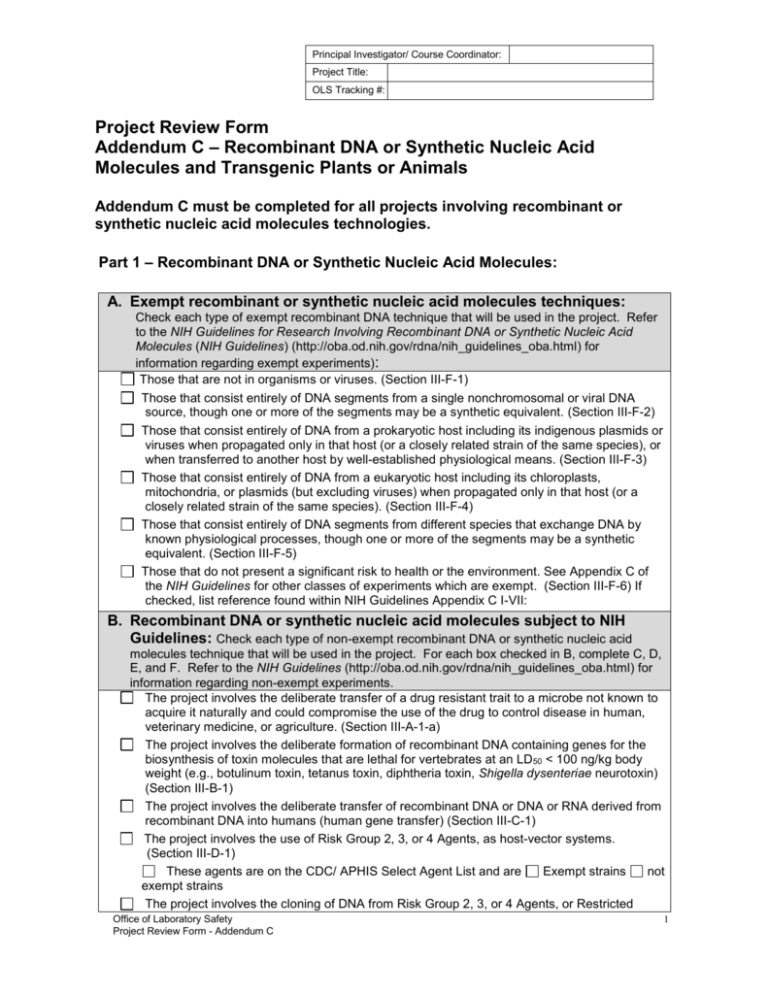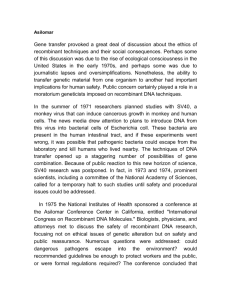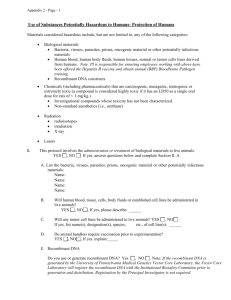Addendum C – RECOMBINANT DNA: Complete this section if your
advertisement

Principal Investigator/ Course Coordinator: Project Title: OLS Tracking #: Project Review Form Addendum C – Recombinant DNA or Synthetic Nucleic Acid Molecules and Transgenic Plants or Animals Addendum C must be completed for all projects involving recombinant or synthetic nucleic acid molecules technologies. Part 1 – Recombinant DNA or Synthetic Nucleic Acid Molecules: A. Exempt recombinant or synthetic nucleic acid molecules techniques: Check each type of exempt recombinant DNA technique that will be used in the project. Refer to the NIH Guidelines for Research Involving Recombinant DNA or Synthetic Nucleic Acid Molecules (NIH Guidelines) (http://oba.od.nih.gov/rdna/nih_guidelines_oba.html) for information regarding exempt experiments): Those that are not in organisms or viruses. (Section III-F-1) Those that consist entirely of DNA segments from a single nonchromosomal or viral DNA source, though one or more of the segments may be a synthetic equivalent. (Section III-F-2) Those that consist entirely of DNA from a prokaryotic host including its indigenous plasmids or viruses when propagated only in that host (or a closely related strain of the same species), or when transferred to another host by well-established physiological means. (Section III-F-3) Those that consist entirely of DNA from a eukaryotic host including its chloroplasts, mitochondria, or plasmids (but excluding viruses) when propagated only in that host (or a closely related strain of the same species). (Section III-F-4) Those that consist entirely of DNA segments from different species that exchange DNA by known physiological processes, though one or more of the segments may be a synthetic equivalent. (Section III-F-5) Those that do not present a significant risk to health or the environment. See Appendix C of the NIH Guidelines for other classes of experiments which are exempt. (Section III-F-6) If checked, list reference found within NIH Guidelines Appendix C I-VII: B. Recombinant DNA or synthetic nucleic acid molecules subject to NIH Guidelines: Check each type of non-exempt recombinant DNA or synthetic nucleic acid molecules technique that will be used in the project. For each box checked in B, complete C, D, E, and F. Refer to the NIH Guidelines (http://oba.od.nih.gov/rdna/nih_guidelines_oba.html) for information regarding non-exempt experiments. The project involves the deliberate transfer of a drug resistant trait to a microbe not known to acquire it naturally and could compromise the use of the drug to control disease in human, veterinary medicine, or agriculture. (Section III-A-1-a) The project involves the deliberate formation of recombinant DNA containing genes for the biosynthesis of toxin molecules that are lethal for vertebrates at an LD50 < 100 ng/kg body weight (e.g., botulinum toxin, tetanus toxin, diphtheria toxin, Shigella dysenteriae neurotoxin) (Section III-B-1) The project involves the deliberate transfer of recombinant DNA or DNA or RNA derived from recombinant DNA into humans (human gene transfer) (Section III-C-1) The project involves the use of Risk Group 2, 3, or 4 Agents, as host-vector systems. (Section III-D-1) These agents are on the CDC/ APHIS Select Agent List and are Exempt strains not exempt strains The project involves the cloning of DNA from Risk Group 2, 3, or 4 Agents, or Restricted Office of Laboratory Safety Project Review Form - Addendum C 1 Principal Investigator/ Course Coordinator: Project Title: OLS Tracking #: Agents into nonpathogenic prokaryotic or lower eukaryotic host-vector systems. (Section IIID-2) These agents are on the CDC/ APHIS Select Agent List and are Exempt strains not exempt strains The project involves the use of infectious DNA or RNA viruses or defective DNA or RNA viruses in the presence of helper virus in tissue culture systems. (Section III-D-3) The project involves whole animals in which the animal’s genome has been altered by stable Introduction of recombinant DNA, or DNA derived therefrom, into the germ-line (transgenic animals) that require BSL-2, BSL-3, or BSL-4 containment and experiments involving viable recombinant DNA-modified microorganisms tested on whole animals. (Section III-D-4) The project involves experiments to genetically engineer plants by recombinant DNA methods, to use such plants for other experimental purposes, to propagate such plants, or to use plants together with microorganisms or insects containing recombinant DNA. (Section IIID-5) The project involves experiments with greater than ten liters of culture. (Section III-D-6) The project involves experiments with influenza viruses generated by recombinant methods (Section III-D-7) The project involves the formation of recombinant DNA molecules containing no more than 2/3 of the genome of any eukaryotic virus. (Section III-E-1) The project involves recombinant DNA-modified whole plants, and/or experiments involving recombinant DNA-modified organisms associated with whole plants, except those that fall under Section III-A, III-B, III-D, or III-F. (Section III-E-2) The project covers experiments involving the generation of rodent in which the animal’s genome has been altered by stable introduction of recombinant DNA, or DNA derived therefrom, in to the germ-line (transgenic rodents) that require BSL-1 containment. (Section III-E-3) C. For exempt recombinant or synthetic nucleic acid molecules experiments, provide a description of the work to be performed. Include the host vector(s), recombinant or synthetic nucleic acid molecules that will be generated, drug resistance markers used, and host cells for propagation or expression of the recombinant DNA. D. For recombinant or synthetic nucleic acid molecules subject to NIH Guidelines, list the name of the gene or nucleic acid fragment, its source (genus, species, strain), the nature of the insert, and the protein expressed. E. For recombinant or synthetic nucleic acid molecules subject to NIH Guidelines, list vectors or plasmids that will be used. Specify commercial source and host. Insert or attach construct maps as necessary. F. For recombinant or synthetic nucleic acid molecules subject to NIH Guidelines, list the host cells into which the recombinant or synthetic nucleic acid molecules will be introduced. For prokaryotic cells and lower eukaryotes, indicate genus, species, and strain. For cultured cells, provide names of cell lines, the derivation of primary cultures, and the species from which they were obtained. G. For recombinant or synthetic nucleic acid molecules subject to NIH Guidelines, describe the recombinant or synthetic nucleic acid molecules that will be generated and the manner in which they will be used in the project. Experimental protocols may be attached. Office of Laboratory Safety Project Review Form - Addendum C 2 Principal Investigator/ Course Coordinator: Project Title: OLS Tracking #: Part 2 – Laboratory personnel: H. List relevant background and experience of the PI/CC and laboratory personnel for the agents and materials to be used and the work to be performed. If you are submitting multiple addenda please provide this information once. Name Background and Experience Part 3 – Facilities and safety practices: I. List precautions that will be taken to limit occupational exposure to hazardous molecules or infectious materials generated through the recombinant or synthetic nucleic acid molecules work described. Include personal protective equipment, use of safe sharps, etc. J. List precautions that will be taken to prevent release of harmful recombinant or synthetic nucleic acid molecules products into the environment. Discuss decontamination or deactivation procedures, waste disposal procedures, If genetically modified plants and animals are generated, describe disposal procedures that will be employed. K. List precautions that will be taken to ensure that unauthorized personnel do not gain access to recombinant or synthetic nucleic acid molecules. Office of Laboratory Safety Project Review Form - Addendum C 3





